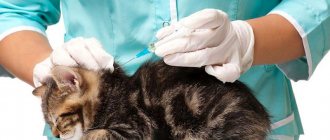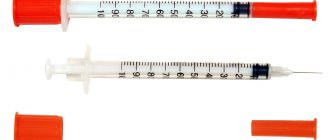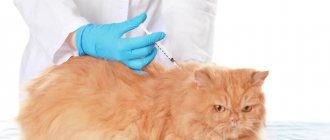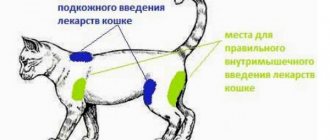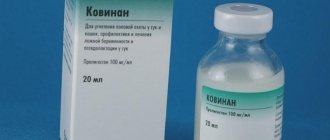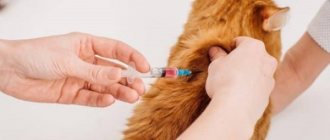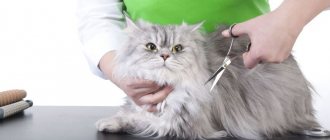Every pet owner wants to see their animal in good health. But, unfortunately, like all other representatives of the fauna, they can also get sick. At the same time, for treatment, many veterinarians prescribe medications in the form of injections, which are in no way inferior in effectiveness to tablets, or even surpass them.
Experienced specialists can easily inject a cat in the thigh due to the specifics of their work. But pet owners, in turn, should also know how to do this procedure correctly and safely.
The need for injections
First of all, it is worth understanding that a prick and an injection are the same thing. That is, this means administering the drug by piercing the skin and tissue of a certain type (muscle). Almost every cat owner has had to take their pet to a veterinary clinic and see how this procedure is performed. Injections can be given on a regular basis (scheduled vaccinations) or carried out after the tailed animal has been injured - in order to maintain its immune system.
As we are all well aware, it is often impossible to recover without medications. It’s the same with pets: without the intervention and help of the owners, the disease will not go away. And since injections are highly effective in treatment, it is worth learning how to inject a cat in the thigh.
As a result, this will save not only time, but also money. In addition, the procedure can be performed urgently and thereby save the animal’s life.
Efficacy of intramuscular injection
Why do many experts recommend intramuscular injections for pets? Any pet owner may have a similar question. This need is due to pure physiology: the fact is that muscle tissue is penetrated by many blood vessels. And if solutions are injected into it for medicinal purposes, they are almost instantly absorbed into the bloodstream.
Moreover, you need to prick exactly in the back of the animal’s thigh. You can, of course, limit yourself to a subcutaneous injection (this is an injection into the cat’s withers), but in this case a strong reaction and pain syndrome may occur. In addition, the medicine takes much longer to dissolve from the subcutaneous tissue, which is why infiltrates may begin to develop.
Muscles are distinguished by the fact that they have a network of lymphatic and blood vessels. Therefore, nothing interferes with the absorption of injected drugs. Learning how to give injections is not difficult, but you should know a number of important rules. Actually, all this will be discussed further.
Special problem cases
It is advisable to examine several specific problems in more detail.
When the kitten resists
Cats are very sensitive to a person’s mood, so nervousness and anxiety are transmitted to them instantly. So the first piece of advice is to deal with the animal’s resistance calmly, without aggression or irritation. A small kitten will not bite you much, but if the animal is large (Maine Coon breed), then you can wrap it in a towel.
The cat is afraid of an injection
For the same reasons, you should not worry or worry if the cat shows anxiety before the injection. Perhaps your mistake is that after the injection you do not give the kitten a treat, do not pamper it, or you yell at it so that it does not move.
However, the kitten’s increased anxiety may not be related to your actions, but may be the result of the animal’s mental properties.
Blood appears after injection
It is normal if a couple of drops of blood remain on the skin after the injection. It can be wiped with cotton wool; there is no need to disinfect the stake site. But if there is heavy bleeding, you need to consult a doctor, since the kitten’s blood does not clot. You must first apply ice to the injection site.
Soreness and lameness
Soreness at the injection site is normal and occurs frequently. However, it goes away quite quickly. So if after a couple of hours the animal is still limping or crying, then you need to massage the paw and apply ice to the injection site. The pain goes away on its own in most cases, but if discomfort continues, you should consult a doctor. Perhaps a bone, a large vessel was touched, or an allergic reaction began.
Preparatory stage
Since an injection for pets is somewhat reminiscent of an operation, then, like any procedure, it should only be carried out under sterile conditions! In general, an intramuscular injection (we already know where to inject an injection into the thigh of a cat) is not difficult, but everything must be done correctly. Otherwise, you should not hope for effective treatment.
In addition, it is important to use only those medications that are prescribed by a veterinarian, and not on the advice of a neighbor - they say, he treated his cat this way. In each specific case, diagnosis is important, and only after it has been carried out can the doctor prescribe the necessary course of treatment. Therefore, it is better not to self-medicate and leave the choice of drugs to a specialist.
It is worth considering that cats feel like masters in their own territory, and if they are scared or in an aggressive state, then the owner runs the risk of being bitten or scratched.
Syringe
You should take the choice of a syringe seriously, because if something happens, you can give the animal an infection. Just as in the case of people, injection instruments for pets must be new (fortunately, they are inexpensive, because they are, in fact, consumables, and for one-time use) and must be sterile.
The choice of a syringe for injecting a cat intramuscularly largely depends on the type of drug and its dosage. Often, most veterinarians recommend the use of insulin syringes. They have a thin and short needle, due to which minimal discomfort will be caused to the animal. This is the best solution for kittens!
However, if the dosage prescribed by the veterinarian exceeds 1 ml, it is worth purchasing a 2 ml instrument. It also does not have a thick needle, but this is quite enough for injections with solutions with particles. However, an even larger syringe may be required. Then it is better to inject with a large needle than to prick several times with a small one.
In any case, here it is worth relying on the recommendations of a veterinarian. Only he has the right to decide which drug and syringes to use in each specific case.
How to give a hypodermic injection to a cat
For subcutaneous administration, it is better to use syringes with a volume of 2 or 3 ml. If you need to inject a medicine in a dose of less than 1 ml, use a syringe to inject insulin, replacing the needle on it. The needle from an insulin syringe is too thin and short for subcutaneous injection into a cat, so it is better to take a needle from a 2 gram syringe. When administering drugs subcutaneously, adhere to the general rules for preparing for injection given above. An injection under the skin is often made in the withers area; this area is less sensitive to pain.
A drug
The dosage prescribed by the veterinarian, including his recommendations, must be strictly followed. When thinking about how to properly give an injection to a cat, it is also worth considering that some medications can be placed both in the withers and in the muscle, while others can only be placed in a strictly defined place. In this case, the volume of the drug is always indicated in cubes, but this is equivalent to millimeters.
It is also important to carefully read the instructions for the medicine. Some of them need to be stored only in the refrigerator, others are designed for one-time use, and others even require dilution with water.
Important Rules
Before proceeding directly to the procedure, owners should study a number of important rules, or even, rather, requirements:
- It is prohibited to mix drugs in one syringe unless directed by the doctor.
- The procedure itself should be performed only with clean hands. The sterility of not only the instrument itself, but also its needle is also important.
- If the ampoule contains a cold drug, you should first warm it up in your palms to body temperature.
- After drawing the medicine into the syringe, it is necessary to lift it up with the needle and release all air bubbles by pressing the piston. In this case, a few drops of solution will be squeezed out - a necessary measure.
We now know where to give a cat an intramuscular injection, but as for kittens, there are no special rules in this case.
It’s just that the owners should act more carefully, since the scope for manipulation is limited. The only difference is not in the method of administration of the drug, but in its dosage.
Preparing for the injection
In order for the procedure to be as comfortable and quick as possible for you and your furry patient, it is important to prepare in advance.
- Before the procedure, wash your hands thoroughly with soap and disinfect them with alcohol.
- Calm the cat, pet it, give it a treat and prepare the place where you plan to give the injection. The surface on which the cat will sit during the procedure should be non-slippery, smooth, and most importantly, comfortable for you (you can use a table, cabinet or sofa).
- Prepare everything you need for the injection: alcohol (or other disinfectant), a syringe with pre-drawn medicine, cotton wool or cotton pads, fixatives, a soft blanket. Use sterile disposable syringes.
- Having calmed and prepared the animal, you need to examine the skin in the area where the injection was given; there should be no irritation, redness or inflamed areas.
- If long hair makes the procedure difficult, it can be cut in the area where the medication is administered.
How to choose a syringe and needle
The choice of syringe for injection depends on the following factors: what kind of injection is planned - subcutaneous or intramuscular, what volume of the drug needs to be administered, what age and size of the pet, what viscosity (stringency) the drug has, what is the degree of pain during its administration.
When choosing a syringe, proceed from the condition that the injection must be given as quickly as possible. To do this, you should pay attention to the consistency of the drug - if the liquid is thick, viscous, viscous, oily or has the properties of a suspension, the needle should be thicker. Such a solution can clog a thin needle, and the injection will take longer, which will only increase the stress of the animal. Conversely, it is worth choosing a thinner needle for thin preparations - this way the unpleasant sensations from the injection will be minimized.
It is safest to administer intramuscular injections to cats using insulin syringes or 2 ml syringes.
If the drug is non-painful and water-based, it is advisable to use a syringe with the thinnest possible needle. So, the injection will be the least painful and minimally injure the muscle tissue. For dosages of 1 ml or less, an insulin syringe with a short, thin needle can be used. Insulin syringes are safest to use for injections in small kittens.
Preparing the medicine
Before you start taking the medication, it is important to carefully read the instructions for the drug and the doctor’s prescriptions. If you have any doubts or questions, be sure to contact your doctor. Or call your veterinarian to make sure the dosage and method of administration are correct before you give the injection.
Make sure that the method of administration of the drug corresponds to the manufacturer's description. Medicines can be used for subcutaneous, intramuscular, or intravenous injections, and it is important to know for sure that the drug can be administered in one way or another. Some drugs, if administered incorrectly, can cause tissue necrosis and abscess at the injection site.
If the instructions for the drug indicate only an intravenous route of administration, then such drugs cannot be administered either subcutaneously or intramuscularly, even in the most minimal dosages.
Observe the dosage and markings on the syringe. Check the expiration date of the drug. Warm the drug drawn into the syringe in your hand if it was stored in the refrigerator.
If the drug is produced in the consistency of a powder, it is first diluted in the solvent that comes with the drug, saline solution or novocaine. Check with your doctor for possible methods of dissolution, or follow the instructions for the drug.
If the drug is in a bottle with a rubber cap, for the convenience of taking the drug, you can insert an additional needle to release air from the bottle. This technique will help make taking the medicine easier.
After the medicine is drawn up, you need to empty the syringe of air bubbles. Turn the syringe vertically, gently tap the contents of the syringe, raising air bubbles to the top, and release a few drops of the drug into the air.
Draw the medicine into the syringe immediately before the injection. Remove the protective cap from the needle before injecting, not before. Do not leave the needle exposed to air without a protective cap, as the needle may become contaminated with microflora, which can lead to inflammation at the injection site.
Hurry up, choose a box and find out what gift awaits you
Discount on pet insurance
Promo code copied to clipboard
How to secure a pet?
For a safe and quick injection procedure, it is important to securely, but at the same time gently and carefully, secure the animal. To properly secure a cat for an injection, you need to hold it very carefully. Remember not to hold your pet roughly or forcefully - this can lead to physical injury and severe stress. You cannot hold a cat by the withers, as this does not lead to reliable fixation of the animal, but can lead to serious injuries - damage to the neck muscles and trachea, displacement of the vertebrae.
Special retainer bags can only be used if placing the cat in the bag does not cause a negative reaction in it.
To restrain cats, it is recommended to use the method of soft swaddling or covering with a soft towel in the sphinx position. This gentle and non-scaring approach reduces the risk of injury and makes it possible to give a series of injections in case of a long course of treatment.
Try not to cause your cat additional stress during the procedure. If she is afraid, do not use force to restrain her. The cat will be even more frightened and will try to escape with great effort. Release your pet, let him calm down and understand that nothing bad is happening, repeat the procedure. If the cat calmly reacts to manipulation, then do not use force, act confidently, but gently. While fixing, be careful not to hurt her.
During the procedure, it is very important to talk to your pet in a calm voice, calm him down, and after the procedure, treat him with a tasty treat.
Correct and confident fixation of a furry patient helps reduce the risk of injury for both the cat and the person performing the procedure.
Now that everything is ready, you can proceed directly to the injection.
Calm, just calm!
Before the procedure, the animal should be calmed, because the muscle should be relaxed. To do this, you should take your pet in your arms and bring it into the appropriate state with affection. The area before the injection does not need to be treated with alcohol, but it is advisable to do so after the injection. At the same time, the surface of the skin itself should be healthy, without wounds.
It’s not just the pet that needs preparation—cats sense their owner’s mood very well. For this reason, if fear or severe anxiety has crept into your soul, you should not approach an animal with such a “load.” To begin with, you should calm down and start preparing for the procedure, and only after that go to catch your pet.
How to give an injection to a cat? It is impossible to prepare the pet itself for the procedure, so it is important to create comfortable conditions so that the injection does not result in severe stress. The best option is to stay alone with the cat, but often the injection is not always successful. Therefore, you have to hire an assistant to hold the animal.
How to give an injection at the withers
Before the injection, caress and stroke the animal. Speak calmly and friendly. Hold the cat with the forearm of your right hand, pressing it lightly. If you are injecting with an assistant, then have him press the shoulders with the head with one hand, and the backside with the other, to the surface on which the animal is lying. Take the syringe with the prepared medicine with your right hand, and form a skin fold with your left. To do this, pull the skin with your left hand.
Pierce the skin with a confident movement, aiming the needle under the base of the fold and parallel to the body. The needle is inserted 1 - 2 cm long, not perpendicular to the fold, but at an angle. The skin in the withers area is quite dense and to pierce it you need to apply some force. After the puncture, administer the medicine; the speed of administration for subcutaneous injections does not matter.
Be careful not to puncture the fold of skin all the way through, otherwise the medicine will leak out from the opposite side and you will have to repeat the injection.
Without releasing the fold, remove the needle and syringe. The injection site can be lightly massaged so that the medicine spreads evenly under the skin and does not flow out through the injection hole.
In one subcutaneous injection, significant volumes of drug solutions can be administered - from 30 to 60 ml, depending on live weight.
Intramuscular injection technique
An injection into the muscle fibers is a rather painful procedure for the animal. In addition, some drugs themselves can cause discomfort. Typically these include antispasmodics, antibiotics, and a number of vitamins. It is for this reason that you should calm your pet, because the needle may not even pierce the tense muscle.
Most likely, the animal will resist. Therefore, it is worth preparing the place for the procedure - a flat and hard surface where the “patient” can be securely fixed. In any case, you will need an assistant, because the cat will react unexpectedly to the injection itself: at the most inopportune moment, the pet may jerk sharply and escape.
The entire algorithm for how to inject a cat is as follows:
- One of the participants in the procedure holds the pet firmly, the other needs to securely grab it by the back paw. The injection itself should be done in the back of the thigh - this is where it is the most “meaty”. In this case, you need to prick when the animal relaxes its paw and does not try to pull it out.
- The needle should be inserted perpendicular to the bone so that it enters the muscle and not under the skin. The depth of penetration is no more than 10 mm (for a kitten - 5 mm).
- The process of administering the medicine should be carried out slowly and smoothly (do not press the piston sharply). The more drug should be administered, the slower it should be done. It takes about 3-4 seconds for 1 ml. In this case, an injection of no more than 1.5-2 cubic meters is allowed in one place.
- After the injection is made, the needle is removed and the animal is released. Sometimes it is better to do this to everyone at the same time, otherwise a disgruntled pet may cling to someone in order to take revenge on the “offender.”
How to give a cat an injection if a course of several procedures is prescribed? In this case, injections are carried out in both hind legs alternately - first in one, then in the other, etc. And after the procedure is completed, you should massage the injection site - this promotes rapid absorption of the medicine.
If the injection is done correctly, the procedure usually goes unnoticed for the animal. However, in some cases there may be complications or rather consequences.
How to give an intramuscular injection to a cat - step-by-step instructions
In order to correctly inject a cat into the thigh intramuscularly, the needle is injected into the muscle between the knee and hip joints. To the touch, this is the softest place in the triangle that the joints form (marked in green in the photo below).
So, how to give an intramuscular injection to a cat - step by step:
- Pet and secure the pet yourself or with the help of an assistant. If the injection is performed with an assistant, you can place the cat on its side so that the assistant can fix and hold the paws.
- Find the softest place in the back of the thigh and relax the limb by lightly massaging the muscle and fix it.
- Determine by feeling with your fingers where the bone is located so as not to touch it with the needle. Do not squeeze the cat's muscle during the injection.
- In order to avoid the needle getting into the sciatic nerve or joint, it is necessary to fix the thigh muscles on both sides with two fingers - the thumb and forefinger - and insert the needle into the muscle in the area between the fingers.
- Carefully and quickly insert the needle into the middle of the cat's thigh at approximately a 45-degree angle to a depth of about 1 cm.
- Do not administer the medicine sharply or too quickly, so as not to injure muscle tissue, skin and cause additional pain to the animal. Inject a volume of 1 ml of the drug for at least three seconds.
- Carefully and smoothly remove the needle at the same angle at which it was inserted.
- Do not administer large volumes of medications to your cat at once. If this is necessary, then you need to make several injections in different places.
- If a drop of blood appears, gently press the injection site with an antiseptic cotton swab and hold for several minutes.
- Praise and reassure your pet, treat it with a treat at the end of the procedure.
Intramuscular injection for a kitten
It is advisable that medical manipulations and procedures for children be carried out by veterinary specialists, since the risks of injuring a small patient on their own are very high. If the situation requires urgent help, you will have to give the injection yourself.
In order to give a kitten an intramuscular injection, you need to take into account the peculiarities of the anatomical structure of small animals. The muscles and subcutaneous tissue of kittens are not yet sufficiently developed, the vessels and nerves are not protected by the volume of muscle tissue and are located quite close to the surface of the body.
Therefore, it is important to use thin needles, control the depth of insertion and prevent the needle from entering the bone area. For babies, insulin syringes and 1 ml syringes are the safest. If the medicine is thin, a thin needle will allow you to easily inject the medicine. Also, if you need to administer a thick drug, you can use 2 ml syringes with a minimum diameter needle.
It is important to take into account the fragility of the small patient and carefully fix the kitten, without squeezing too hard when holding it and without frightening it. After the procedure, calm your baby down and treat him to something tasty. So, the injection will not seem scary to the little patient.
Lameness
Sometimes an injection into the thigh of a cat can cause the pet to limp, which is also normal. Particularly sensitive individuals may even harbor a grudge against such interference from the owner. However, there is no need to worry about this.
A cause for serious concern may be when a pet drags a limb or lameness does not go away after a day. This indicates that a nerve has been affected. This condition requires the intervention of a veterinarian, and the sooner the better for the animal. Therefore, after the procedure, you should carefully monitor your pet’s condition.
Useful tips
To inject your cat yourself and avoid complications, you need to adhere to the following recommendations:
- for injections, you should use only a sterile syringe, which must be disposed of after the procedure;
- the needle must not be touched with hands, otherwise it must be replaced;
- Before carrying out the procedure, it is better to fix the pet in a motionless state, leaving only the injection site of the syringe open (you can use a harness, blanket, sheet and other accessories) or invite someone from the side to hold the cat;
- as a rule, injections are made into an intact area of the skin, so if the animal has any skin disease, you must first clarify this issue with a veterinarian;
- there is no need to disinfect the injection site of the syringe, but the owner must first wash his hands with soap and treat them with an antiseptic;
- if the doctor has prescribed injections every day or several a day, it is best to give injections to the paw alternately - right and left or front and back, in order to avoid severe trauma to the cat’s tissues and allow them to heal;
- oil-based medicine should not be allowed to enter the bloodstream; You can make sure that the needle has not entered a blood vessel by slightly pulling the plunger towards you after inserting the syringe - the absence of blood in the solution indicates that the vessels are not affected, and you can continue the procedure;
- You cannot administer more than one drug at the same time in one syringe, unless authorized by a specialist.
To support a mustachioed pet during the procedure, as well as before and after it, you need to talk to it as gently as possible, stroke it, and calm it down. At the end of the manipulations, you should give the cat something tasty.
Every owner can give a cat an injection on their own, the main thing is desire. It’s good if the skill isn’t useful, but mastering it won’t hurt at all.
Cone
Another complication that may appear after an injection is given to an animal is the formation of a lump at the injection site. There are several reasons for this problem:
- allergic manifestation to the administered drug;
- individual reaction of the animal’s body;
- the injection into the feline's thigh was given incorrectly.
In this case, it is necessary to monitor the condition of the “patient”. And if within two days the dynamics do not change in a positive direction, you should go to the clinic. This is especially true in cases where the injection site has become hot and red. Then a trip to the veterinarian cannot be postponed, and the animal must be taken for examination as soon as possible.
Often the formation of a lump is associated with the accumulation of a purulent mass, and this is already the focus of a dangerous inflammatory process.
Possible complications
As a rule, injections do not cause negative consequences. But sometimes they can arise not only from an inexperienced owner, but also from a specialist. It is important to know about possible complications in order to provide your pet with the necessary help in a timely manner.
If you inject your cat incorrectly, for example, by injecting the drug into the wrong place, damaging a blood vessel, or hitting a nerve, problems may include the following:
- If at the injection site after removing the needle drops of blood appeared
, then this indicates damage to the wall of the blood vessel. If a few drops of blood are released, then to stop the bleeding it is enough to apply cold to the injection site for 10-15 minutes (ice or a frozen product from the freezer, wrapped in a clean cloth or a damp, cold towel).
- Infiltration or compaction
(bump, swelling) at the injection site indicates that the injected medicine is not absorbed into the bloodstream, or an inflammatory process has begun in the injured tissue or surrounding tissues. The causes of infiltration may be: the introduction of too much of the drug at once, infection along with it, very rapid administration of the drug, an allergic reaction of tissues, the use of drugs without prior warming to body temperature. What to do in such a situation? If the infiltrate does not resolve, does not go away for a long time, the area of compaction becomes hot, painful, increases in size, the animal’s well-being worsens, it is necessary to show the cat to a veterinarian.
- Long-term non-absorbable infiltrates and compactions can lead to the occurrence of abscesses
. A purulent inflammation forms in the infiltrate cavity or at the site of compaction; the injection site may swell, become hot and painful. The cat may refuse to eat, become lethargic, apathetic, and its body temperature will rise. This condition is dangerous and in severe cases can lead to sepsis and death of the animal. It is important to seek surgical help as soon as possible.
- Lameness after injection
. There can be several causes of lameness. One of them is muscle damage due to the use of tissue irritating solutions, antibiotics and thick, difficult to dissolve drugs, leading to severe pain at the injection site. Lameness can occur as a result of an unsuccessful injection, or as a result of a needle getting into a nerve. As a rule, lameness goes away within an hour after the injection. If the lameness intensifies and does not go away within several days, the limb has lost mobility and cannot straighten, and the cat does not lean on it when walking, it is necessary to show your pet to a doctor.
- Temperature increase.
This reaction of the body can be caused by an allergy to the injected drug, or serve as a symptom of an inflammatory process at the injection site. This can happen if sterility was not maintained during the procedure.
- Severe reaction to stress
. Cats are very sensitive animals. They have a hard time enduring long-term chronic stress, pain and discomfort. If the pet takes the injections too hard, hides after the procedures, becomes fearful and nervous, refuses to eat, does not allow itself to be touched, hides in secluded places and does not come out of them for a long time, then, in agreement with the attending physician, it is advisable to switch as soon as possible. for other forms of drug administration. For example, for tablets or suspensions. To reduce stress levels, you can use special calming synthetic facial cat pheromones in the form of a diffuser.
Pay close attention to your pet's well-being and changes in behavior. If there is refusal to eat, lethargy, fever, pain at the injection site, or bloody or purulent discharge at the injection site, immediately take your pet to a veterinarian.
The following video discusses how to properly inject a cat intramuscularly.
The procedure is ongoing
Without a doubt, the injection is unpleasant for animals and causes them considerable discomfort. Unfortunately, situations may arise when the injection must be given continuously over a certain period of time. In this case, it is worth taking care of maximum comfort for the pet in order to avoid prolonged stress.
It will not be possible to train your pet to endure pain, but there is an opportunity for associative perception:
- Injections into the cat's thigh should be done at the same hours and in the same environment.
- The pet must be in a calm state of mind.
- Immediately before the procedure, you should begin to establish contact with the animal: stroke it, caress it.
- After the injection, be sure to praise your pet and give him his favorite treat.
Following these recommendations will help the animal endure discomfort more patiently and be calmer.
